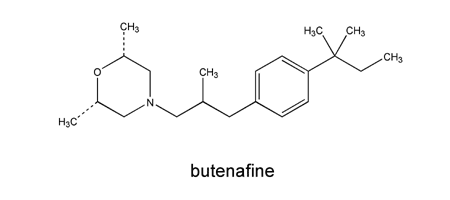Manufacturer’s Prescribing Information
Trade & Generic Names & General Features
Butenafine (N-4-tert-butylbenzyl-N-methyl-1-naphthalenemethyl-amine hydrochloride) is a benzylamine derivative and a new generation topical antifungal compound. It has favorable activity against various dermatophytes, as well as Candida albicans. Butenafine achieves high concentrations in skin and remains in skin tissue for prolonged periods (24 hours in guinea pigs). It is mostly distributed in epidermis. A small amount is detectable also in dermis, probably due to its transport via sebaceous glands and hair follicles. Importantly, butenafine exerts anti-inflammatory as well as antifungal activity in vivo. This property is particularly beneficial in dermatophytic infections that are accompanied by a marked inflammatory reaction in the infected tissue. Butenafine is soluble in water as well as in methanol, ethanol, dichloromethane, and chloroform [1502, 1606, 2210].
Butenafine has 1% cream formulation. It is being manufactured by Penederm, Inc. and its trade name is Mentax.

Mechanism(s) of Action
Similar to allylamines, butenafine inhibits ergosterol biosynthesis by blocking squalene epoxidation [2210].
Susceptibility Patterns
It is mainly active against dermatophytes. The most striking feature of butenafine is its superior fungicidal activity against this group of fungi when compared to that of terbinafine, naftifine, tolnaftate, clotrimazole, and bifonazole. It is active also against Candida albicans and this activity is superior to that of terbinafine and naftifine. Butenafine also generates low MICs for Cryptococcus neoformans and Aspergillus spp. as well [1104, 1400, 1502, 2210].
Optional in vitro susceptibility testing parameters for butenafine remain have not been defined. However, there are some in vitro data reported. Butenafine yields lower MICs and MFCs for Microsporum canis, Microsporum gypseum, Trichophyton mentagrophytes, Trichophyton rubrum and Epidermophyton floccosum compared to naftifine, tolnaftate and clotrimazole [1502, 2210].
For butenafine MICs obtained for various types of fungi, see susceptibility patterns and the N/A(L):susceptibility database.
Usual Doses
Butenafine cream is applied once or twice daily on the infected area. Duration of therapy varies with anatomic location of the infection. In (A):tinea pedis, (A):tinea cruris or (A):tinea corporis, 2 to 4 weeks of therapy is most common [900, 945].
Side-Effects
Topical butenafine is well-tolerated and adverse reactions are rare. Mild burning sensation at the application site has been observed in some patients [1321, 2210].
Routes
Butenafine is available for topical administration in 1% cream formulation.
Current Status
Butenafine appears as an alternative for treatment of various dermatophytosis, such as tinea pedis, tinea cruris, tinea corporis, and onychomycosis. Its rapid and persistent antifungal activity is attractive [900, 1321, 1502, 2036, 2210, 2260].
While oral antifungal therapy is still the treatment of choice for onychomycosis [945], the efficacy of several topical agents, as well as butenafine, is being investigated for this particular setting. The efficacy of butenafine in combination with Melaleuca alternifolia (tea tree) oil has been investigated in patients with toenail onychomycosis. The cream formulation consisting of 2% butenafine hydrochloride and 5% Melaleuca alternifolia (tea tree) oil achieved clinical cure in 80% of the patients after 16 weeks [2211]. Similarly, application of 2% butenafine and 20% urea incorporated in cream formulation leaded to clinical improvement in 73.3% of the patients with big toenail onychomycosis [2209].
